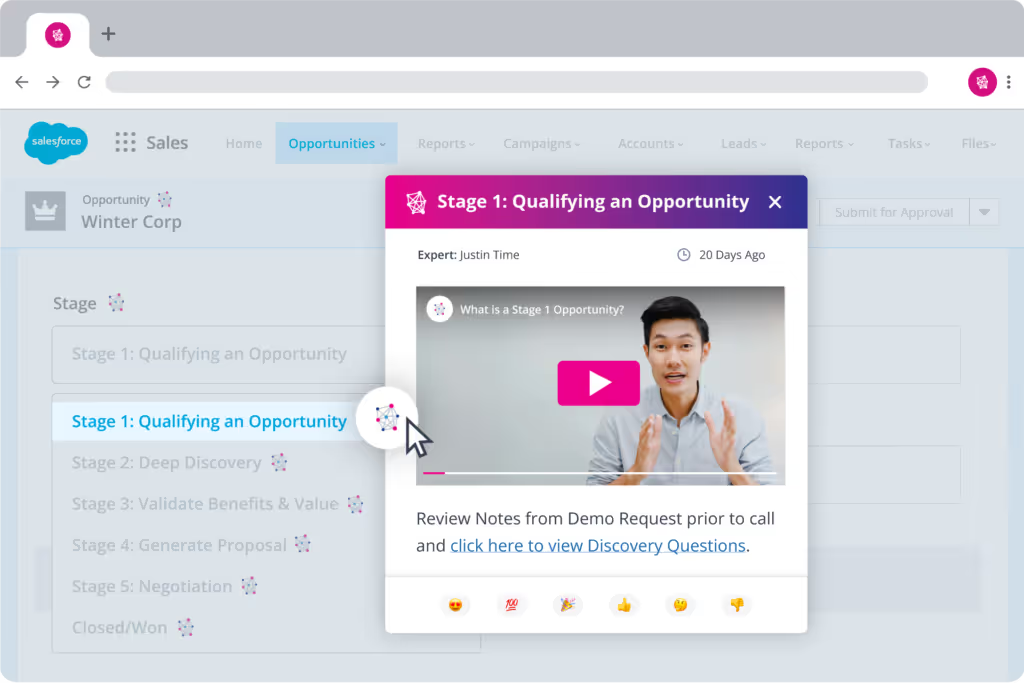Value-based selling focuses on the value that a product or service provides to the prospect. According to a study, 87% of companies prefer value-based selling to understand the effectiveness of their sales process. Compared to other models, value-based selling models result in more closed deals, improved upselling, and increased customer trust and loyalty. Sounds pretty good, right?
In this post, we’ll explore the world of value-based selling, looking at examples, benefits, and strategies to help your sales team fill their pipeline and crush their quotas. Whether you’re a seasoned professional looking to refine your sales process or a business owner aiming to unlock the full potential of your product, this guide will provide you with the insights and tools you need to thrive in today’s competitive market.
Value Selling Meaning
“Value selling” is a sales methodology that emphasizes the benefits of a product or service to the prospect throughout the sales process. It’s also known as “value-added selling” and can include consultative selling.
Value selling aims to showcase how a solution will solve the prospect’s problems and provide significant benefits. It could include highlighting outstanding quality, superior customer service, long-term cost savings, or any other factors that differentiate the product or service from competitors. This builds anticipation for the positive outcomes customers can expect from your solution.
Value selling can also lead to stronger relationships with prospects because the sales rep actively listens to them to uncover what truly matters.
Feature Selling vs. Value Selling
Unlike value selling, feature selling pays more attention to showcasing a solution’s specifications, functionalities, and attributes. While this method has its merits – especially for prospects who are interested in technical details – it can leave the prospect struggling to see the practical implications of the features presented.
Value selling is a holistic approach that focuses on the customer’s journey and the transformative power of the solution you’re offering. It’s about painting a vivid picture for the prospect, showing them how the product or service fits seamlessly into their world and solves their problems.

Value Selling Example
Let’s look at an example of value selling:
Imagine you’re a SaaS company that offers project management software. If you were to adopt a feature-centric approach, your sales pitch might sound like this:
“We have a project management software with features like task tracking, file sharing, and team collaboration.”
However, in a value selling approach, instead of overwhelming the prospect with features, the sales rep engages them in a thoughtful conversation. They ask questions, listen actively, and focus on the prospect’s pain points. They don’t just talk about what their solution can do – they illustrate how it can specifically solve the prospect’s problems, save time, and boost their efficiency.
Your sales pitch might now look like this:
“We understand that your current project management processes are time-consuming and often result in missed deadlines and miscommunication. Our software streamlines task tracking, facilitates seamless file sharing, and enhances team collaboration. By implementing our solution, you can increase project efficiency by 30%, reduce missed deadlines by 50%, and improve team productivity. These improvements translate into cost savings and increased profitability for your business.”
This second pitch demonstrates a customer-centric approach, emphasizes benefits over features, and quantifies the impact on the prospect’s business. The prospect will feel heard, understood, and empowered.
The choice becomes obvious, and as the value-driven partner, you win the prospect’s trust and business.
Benefits of Value-Based Selling
Let’s take a look at some advantages of employing a value-based selling approach:
Improves Buyer-Seller Relationships
In a world where prospects are bombarded with impersonal options, a genuine connection can be the differentiating factor that makes prospects choose your brand over competitors. Approximately 82% of sales reps now act as valuable consultants, assisting buyers in solving complex problems and addressing specific needs.
This personalized approach will help your sales professionals develop a closer and longer-lasting customer relationship. Evolving your sales practices from a one-off transaction to a value-driven partnership enables you to secure predictable, sustainable revenue through cross-sells, upsells, and renewals.
Closes (Bigger) Deals Faster
When prospects understand the tangible value they stand to gain, they’re more inclined to commit to larger deals, increasing the overall revenue generated per sale. Companies implementing value selling can improve their new customer close rate by as much as 70%.
When you focus on presenting the unique value your offering brings to them, you streamline their decision-making process and eliminate objections. This proactive approach allows sales professionals to guide prospects seamlessly through every stage of your sales pipeline.
How to Sell Through With a Value Selling Framework

Value-based selling isn’t just a strategy – it’s a mindset. To help you succeed, here’s a step-by-step guide on how to sell effectively using the value selling framework.
1. Research, Research, Research
Before engaging with your prospect, it’s time for research. Understand their pain points, industry challenges, and specific needs.
Plus, you need to have in-depth knowledge of your product or service – and the value it provides. What sets it apart? How does it address common problems? What benefits have previous customers seen? The more informed you are, the better you can tailor your pitch.
This is where Spekit can help. Spekit is a just-in-time enablement platform that provides instant access to up-to-date information about your solution, prospects, competitors, and more. The platform:
- Eliminates friction and learning barriers in the sales process by helping your team save as much as 69% of valuable time traditionally wasted searching for crucial information, addressing repetitive inquiries, and participating in lengthy training sessions.
- Offers bite-sized knowledge and training precisely when and where your employees require it – seamlessly integrated into their daily work tools and applications. This empowers them to excel in their roles and produce tangible business results.
- Accelerates the onboarding process for new team members by 50%, helping you prevent attrition and boosting your retention rates.
- Includes quick knowledge assessments and real-time analytics, enabling organizations to identify knowledge gaps, strengthen essential information, evaluate the effectiveness of enablement initiatives, and ensure sales reps adhere to processes and best practices.
- Uses AI to help streamline training and content creation. Spekit AI can search and find relevant content to show prospects by analyzing emails and call summaries. Condense lengthy documentation and SOPs and generate training bits for sales teams to use and learn from. Sales reps can also use Spekit AI to generate new playbooks, sales scripts, and more in a matter of minutes.

With Spekit, reps can access the exact information right when they need it, so they can focus on value selling with every lead without having to leave the context of what they’re doing.
“With the help of Spekit, questions never go unanswered. Spekit has significantly reduced the time that employees are spending searching for content.” GLORIA RAMCHANDANI, SR. DIRECTOR, STRATEGY & BUSINESS OPERATIONS AT COPADO
2. Save Your Sales Pitch
Instead of launching into a pre-rehearsed pitch, start by actively listening. Let the prospect express their challenges and goals. Your aim should be to comprehend deeply before presenting solutions. This patient approach builds trust and positions you as an expert consultant and resource rather than a traditional salesperson.
3. Understand Your Solution’s Value
While it’s important to know your solution’s capabilities, you must also know how these translate into tangible benefits for the prospect. How will your solution make their life easier, their business more efficient, or their customers happier?
Clearly articulate the value proposition in a way that directly addresses their specific needs and includes real-life examples from past clients whenever possible.
How can teams make sure they’re always value selling throughout every conversation? With Spekit.
Spekit provides revenue strategies, objection handling insights, sales battle cards, and cheat sheets – when and where the sales activities are happening. This setup eliminates uncertainties, ensuring that the sales team can access and share the right resources with leads without requiring context-switching or interrupting their workflow.

4. Teaching > Selling
Become a valuable resource for your prospect. Offer insights, industry knowledge, and solutions-oriented advice. When you position yourself as an educator, you gain credibility. Empower your prospects to make informed decisions–and they’ll be more likely to choose your solution.
5. Communicate Clearly
Effective communication is a cornerstone of value-based selling. Ask thoughtful questions, actively listen to their responses, and send follow-up communications demonstrating your understanding and commitment. Be your prospect’s friendly guide, navigating them through the complexities of the buying journey.
6. Focus on Your Relationship

People buy from people they like and trust–so be that person!
Be approachable, build genuine connections, and help the prospect open up. A friendly, conversational tone fosters trust and can make the prospect feel comfortable. Remember, it’s not just a transaction: it’s the beginning of a valuable relationship.
More About Value Selling
Let’s review a few final FAQs on value selling.
What is the ValueSelling Framework?
The ValueSelling Framework is a training program offered by ValueSelling Associates that’s designed to empower sales and customer-facing professionals. It focuses on key skills and techniques essential for sales success, including rapid qualification of prospects, aligning solutions with the buyer’s specific business challenges, emphasizing value over price, creating a sense of urgency, gaining access to decision-makers, and conducting purposeful conversations.
The ValueSelling Framework enables professionals to learn how to engage with prospects more effectively, understand their needs, and align offered solutions with the prospect’s world. The training program doesn’t just provide theoretical knowledge; it offers hands-on, interactive workshops reinforcing these skills, allowing participants to develop the necessary “muscle memory” to apply the concepts in real-world scenarios.
The Framework is not a one-size-fits-all solution; it is customized to fit individual organizations, industries, client bases, and roles. This tailored approach ensures that the training is directly applicable and relevant to the challenges faced by the professionals undergoing the program.
What is value selling marketing?
Value selling marketing aligns marketing efforts with the principles of value selling. It goes beyond traditional marketing strategies, focusing solely on promoting a solution’s features and benefits. Instead, value-selling marketing centers on creating content and messaging that resonates with the target audience’s needs, challenges, and aspirations.
Key elements of value-selling marketing include:
- Customer-Centric Content: Creating content that educates and informs prospects and customers about how a product or service can solve their specific problems and improve their lives.
- Persona Development: Understanding your target audience’s personas and tailoring marketing campaigns to address their unique pain points and preferences.
- Storytelling: Using narratives and success stories to illustrate the real-world impact of your solution.
- Empathetic Communication: Fostering a sense of empathy in marketing materials so customers feel understood and valued.
Spekit supports marketing teams too. By embedding essential resources such as persona cards, case studies, and campaign guidance directly into the workflow, Spekit equips marketing teams to empower their sales teammates.
This efficiency not only allows sales teams to focus entirely on their core task of selling but can also drive a remarkable 20% increase in quota attainment. In the words of Keegan Otter from Sendlane,
“Having Spekit is a confidence boost for the entire organization. In our last eNPS scoring, we ranked the highest for providing the resources and knowledge employees need to perform at their job.”
Spekit also provides a centralized repository for marketing resources, making them instantly accessible to everyone. This eradicates the confusion stemming from scattered documents and guarantees that every team member operates from the same page.
Knowledge checks and analytics assess information retention and engagement, ensuring that key concepts are thoroughly understood.
Is there value selling training?
Many companies offer value-selling training programs for their sales teams. These programs typically cover various topics, including understanding prospect needs, effective communication and listening skills, and presentation strategies emphasizing value over features.
Additionally, there are third-party organizations that offer sales training tools that can benefit sales professionals across industries.
Improve Your Value Selling Strategies
Sales in the modern era involves prospects seeking not only products or services but also transformative experiences. Value-based selling stands as a guide toward those meaningful interactions. It’s not just about selling a solution; it’s about solving a problem, listening to the prospect’s voice, and forging lasting connections.
To implement your strategies effectively, close more deals, and boost sales–you need the right tool for the job. And that’s Spekit.
Spekit ensures that sales reps can instantly access content tailored to the unique situation of each lead. Instead of teams sifting through a vast repository of information, they receive just-in-time guidance, enabling them to frame conversations to focus on the value your solution is providing.
Spekit minimizes context switching by embedding relevant content directly into the tools the sales reps are already using. This streamlined process allows reps to stay focused on listening to prospects – one of the key aspects of value-selling.
Ready to help your team improve their value-based selling techniques?
Book a demo with Spekit today!







